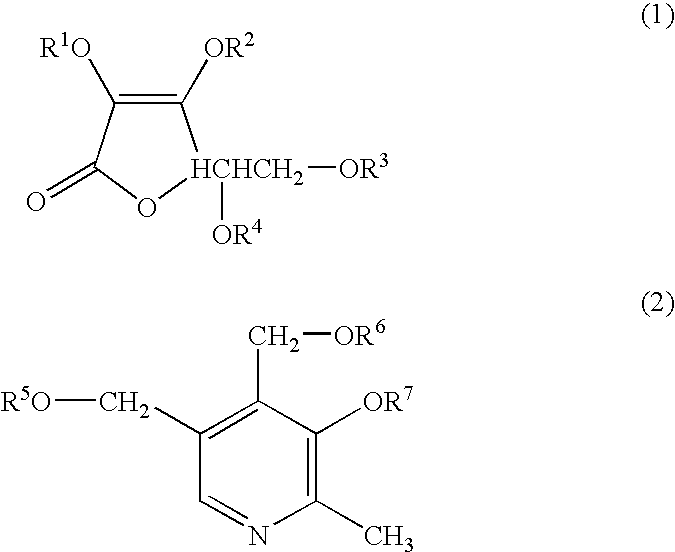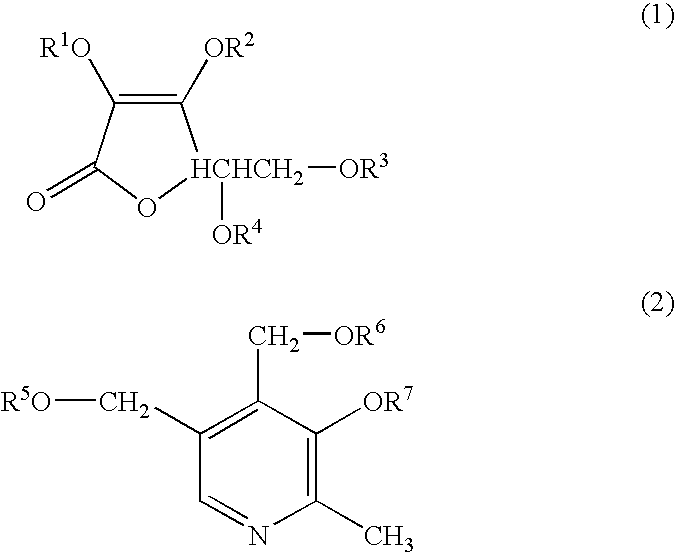Solder ball
a technology of solder balls and solder balls, which is applied in the field of solder balls, can solve the problems of reduced yield, difficulty in completely preventing mounting errors, and limited organic compounds that cannot prevent the change in color sufficiently, so as to prevent the micro-bonding of solder balls, prevent the change in color of solder balls, and improve the yield of electronic devices
- Summary
- Abstract
- Description
- Claims
- Application Information
AI Technical Summary
Benefits of technology
Problems solved by technology
Method used
Image
Examples
examples 1 to 9
[0042]In Examples 1 to 9, the surface treatment was applied to solder balls made of Sn-3.0Ag-0.5Cu and having a grain size of 450 μm, and the flowability of the solder balls was evaluated. The surface treatment agents used were sorbitan monolaurate, sorbitan monopalmitate, sorbitan monostearate, sorbitan tristearate, sorbitan trioleate, retinol, tocopherol, pyridoxic acid dipalmitate and ascorbic acid dipalmitate, respectively. In order to coat the solder balls at a rate of 4.4 mg / m2, the surface treatment agent was dissolved in 2-propanol to produce a treatment solution.
[0043]Then, 10 g of the solder balls were sufficiently immersed in 0.8 g of the treatment solution added, and dried in a drying machine at 100° C. (degree C.) for 10 minutes, whereby the solder balls were coated with the surface treatment agent.
[0044]The friction between the thus-obtained solder balls was evaluated with reference to a flowability test method defined by JIS Z 2505. Metal funnels with different orific...
examples 10 to 15
[0049]In Examples 10 to 15, solder balls made of Sn-3.0Ag-0.5Cu and having grain sizes of 30 μm, 70 μm, 250 μm, 300 μm, 450 μm and 1000 μm were subjected to surface treatment, and then the flowability of the solder balls was evaluated. Pyridoxic acid dipalmitate which effectively worked in Example 8 was used as the surface treatment agent. The solder ball was coated with the surface treatment agent at a rate of 4.4 mg / m2 by the above-mentioned method. Evaluation of the flowability of the solder balls was performed by changing the orifice diameter of the funnel and the amount of sampling according to the grain size of the solder ball. The flowing times of the solder balls were measured on the following conditions. For the solder balls of 30 μm in grain size, the orifice diameter of the funnel was 0.2 mm, and the amount of sampling was 0.25 g. For the solder balls of 70 μm in grain size, the orifice diameter of the funnel was 0.3 mm, and the amount of sampling was 0.5 g. For the solde...
examples 16 to 25
[0054]In Examples 16 to 25, solder balls made of Sn-3.0Ag-0.5Cu and having a grain size of 450 μm were subjected to the surface treatment, and the flowability of the solder balls was evaluated. The surface treatment agents in use were pyridoxine monocaprylate, pyridoxine dicaprylate, pyridoxic acid monopalmitate and pyridoxic acid dipalmitate which were vitamin B6 derivatives, and ascorbic acid monopalmitate, ascorbic acid dipalmitate, ascorbic acid monostearate, ascorbic acid distearate, ascorbic acid tetraisopalmitate and ascorbyl tetra-hexyldecanoate which were vitamin C derivative. The solder balls were coated with the surface treatment agents at a rate of 4.4 mg / m2. The flowing times of the solder balls subjected to the above surface treatment were measured in the same way as Example 1.
[0055]Table 3 shows the results of Examples 16 to 25. As can be seen from Table 3, the solder balls of the present invention shown in Examples 16 to 25 have improved flowability by coating the so...
PUM
| Property | Measurement | Unit |
|---|---|---|
| grain size | aaaaa | aaaaa |
| grain size | aaaaa | aaaaa |
| thickness | aaaaa | aaaaa |
Abstract
Description
Claims
Application Information
 Login to View More
Login to View More - R&D
- Intellectual Property
- Life Sciences
- Materials
- Tech Scout
- Unparalleled Data Quality
- Higher Quality Content
- 60% Fewer Hallucinations
Browse by: Latest US Patents, China's latest patents, Technical Efficacy Thesaurus, Application Domain, Technology Topic, Popular Technical Reports.
© 2025 PatSnap. All rights reserved.Legal|Privacy policy|Modern Slavery Act Transparency Statement|Sitemap|About US| Contact US: help@patsnap.com


